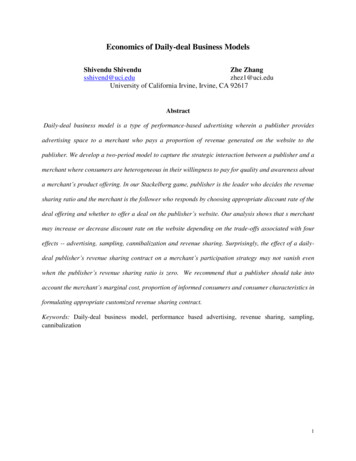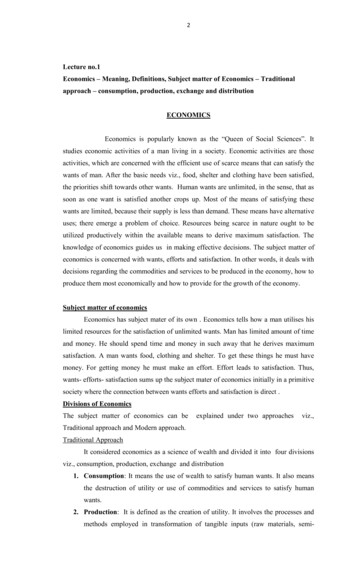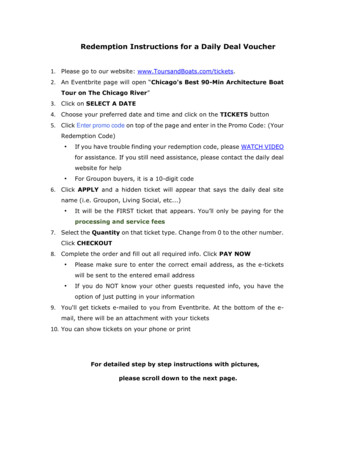
Transcription
Economics of Daily-deal Business ModelsShivendu ShivenduZhe Zhangsshivend@uci.eduzhez1@uci.eduUniversity of California Irvine, Irvine, CA 92617AbstractDaily-deal business model is a type of performance-based advertising wherein a publisher providesadvertising space to a merchant who pays a proportion of revenue generated on the website to thepublisher. We develop a two-period model to capture the strategic interaction between a publisher and amerchant where consumers are heterogeneous in their willingness to pay for quality and awareness abouta merchant’s product offering. In our Stackelberg game, publisher is the leader who decides the revenuesharing ratio and the merchant is the follower who responds by choosing appropriate discount rate of thedeal offering and whether to offer a deal on the publisher’s website. Our analysis shows that s merchantmay increase or decrease discount rate on the website depending on the trade-offs associated with foureffects -- advertising, sampling, cannibalization and revenue sharing. Surprisingly, the effect of a dailydeal publisher’s revenue sharing contract on a merchant’s participation strategy may not vanish evenwhen the publisher’s revenue sharing ratio is zero. We recommend that a publisher should take intoaccount the merchant’s marginal cost, proportion of informed consumers and consumer characteristics informulating appropriate customized revenue sharing contract.Keywords: Daily-deal business model, performance based advertising, revenue sharing, sampling,cannibalization1
1.IntroductionDaily-deal business model came to limelight with the advent of Groupon in 2008 which became thefastest online business to reach one billion dollar valuation in history (Steiner, 2010). What differentiatesthis business model from the traditional ecommerce is that though buyers purchase goods online, theyreceive or consume them offline. Therefore, this business model is essentially based on first attractingconsumers online and then directing them to offline local stores. Moreover, this business model isdifferent from traditional advertising models because the purchase loop is completed on the daily-dealpublisher’s website. Since the purchases are completed on the publisher’s website, the publisher, likeGroupon or Living Social, can monitor revenue generated, and, hence, can offer a revenue sharingcontract which may not be viable in the case of traditional advertising. In a revenue sharing contract, amerchant pays to the daily-deal publisher for the advertising services only when a transaction has beencompleted. In that sense the daily-deal business model is a performance-based online advertising model.With the rapid emergence of technologies enabling Location Based Service (LBS) and Social,Local, Mobile (SOLOMO) services, the mobile commerce is expected to grow to 31 Billion in 2016from a level of around 3 Billion in 2010 (Forrester, 2011). This presents unprecedented opportunities forthe local businesses to connect to consumers who are online 24x7 through their Smartphone. Moreover,given that 58% of consumers in the US research products and services online before purchase (Jansen,2010), it is becoming increasingly critical for local brick-and-mortar businesses like restaurants toadvertise their offerings on the mobile platforms. For example, Groupon claims that its deals areinherently local and their distinguishing feature is that they are designed for mobile commerce platforms1.A daily-deal publisher provides space on his website for local businesses or merchants toadvertise their goods to online consumers in the form of “deals of the day”. One feature of these dailydeals is that they are for services, such as restaurants, yoga classes, and tanning salons. Since service is an1See Groupon CEO interview on CNBC on 10/23/2013: http://www.cnbc.com/id/1011368152
experience good, some consumers who have not experienced the good before may have a lower qualityestimate of the good. Therefore, a merchant may offer price discount (Bagwell, 1990) through a dailydeal publisher to encourage first time consumers to try the experience good, and some of these first-timeconsumers may become repeat consumers in future.The unique business model of daily-deal advertising was hailed as the future of online businesses2in the beginning. While daily-deal commerce has seen phenomenal growth in the last five years, marketanalysts have raised concern about its sustainability, growth and profitability (Clifford and Miller, 2012).Furthermore, the business model of daily-deal publishing has itself been questioned (Cohan, 2012; Etter& McMillan, 2012). One critical feature of these business models is that daily-deal publishers often offerstandard revenue sharing scheme to all merchants. For example, while Groupon is known to offerstandard revenue sharing ratio of 50%, LivingSocial’s standard revenue sharing ratio is known to be 40%.It is surprising that the revenue sharing contract in which revenue sharing ratio is decided by the publisherdoes not vary across merchants because merchants who advertise on daily-deal publisher’s website anddecide discount rates for deals, are heterogeneous in term of marginal costs, proportion of existingconsumers, and first time consumers’ quality estimate. Though the daily-deal advertising model isbecoming increasingly important for offline merchants providing services, there is very little academicresearch that has studied the ecosystem of daily-deal advertising business model. Furthermore, there islittle information available in industry reports about how do heterogeneous merchants decide discountrate for the daily-deal and how does publisher decide the revenue sharing ratio.In this paper, we develop a two-period analytical model to abstract the ecosystem of daily-dealpublishing where participating merchants sell goods at the regular price directly to consumers or in thedirect channel, and offer deals on the publisher’s website or the publisher channel. We model the strategicinteraction between the daily-deal publisher and an advertising merchant as a leader-follower game wherethe daily-deal publisher is the leader and the merchant is the follower. More specifically, we answer work/3
following questions: (i) What are the benefits and costs to a advertising merchant in offering a deal on adaily-deal publisher’s website? (ii) What is the optimal discount rate strategy for a merchant? (iii) Howdoes a daily-deal publisher’s revenue sharing ratio affect a merchant’s optimal discount rate strategy? (iv)What types of merchants should offer deals on a daily-deal publisher’s website? and (v) How domerchants’ characteristics affect a daily-deal publisher’s choice of revenue sharing ratio?The daily-deal advertising model is different from the traditional coupon based advertising modelwherein merchants also offer discount to coupon receiving consumers. However, the traditional couponbased advertising is nonperformance-based advertising because a merchant pays a lump sum amount to anadvertiser for a certain number of views/exposures. On the other hand, in the context of daily-dealadvertising, an advertising merchant pays based on revenue generated from consumer purchases. Dailydeal advertising is also different from pay-per-click sponsored search advertising model, where amerchant pays when a consumer clicks on the link. Moreover, in sponsor search advertising, a merchant’sadvertising cost per click is determined through an auction mechanism, and not by the publisher.In the context of daily-deal advertising, each merchant faces a market consisting of two consumersegments, namely, informed consumers and uninformed consumers. While the informed consumers areaware about the merchant and the quality of the experience good, the uninformed consumers are notaware about the merchant, and under-estimate the quality of the experience good on the publisher’swebsite.A local merchant can offer a deal to reach out to uninformed consumers who are on thepublisher’s website. Exposure to these uninformed consumers is the advertising effect of daily-dealbusiness model to the merchant. Moreover, uninformed consumers on the publisher’s website areincentivized to purchase the merchant’s experience good through an attractive deal which offers discount.Those uninformed consumers, who buy the deal, realize the true quality of the experience good, and theirwillingness to pay in the next period increases. Some of these of the first period may buy the experiencegood at regular price in the second period (Rothschild and Gaidis, 1981). This aspect of daily-deal4
publishing is akin to the introductory pricing strategy of under-estimated experience goods (Shapiro1983), and is the sampling effect of daily-deal business model. Moreover, some of the informedconsumers of a merchant, who would have bought at the regular price in the direct channel, may purchasethe deal at a discounted price in the publisher channel. This leads to cannibalization effect, which isrevenue loss to a merchant from informed consumers. In addition, a merchant pays to the daily-dealpublisher a proportion of revenue generated on the website according to the revenue sharing contract.This payment is the merchant’s cost of offering a deal on the publisher’s website.Merchants value these effects of daily-deal publishing differently because of their inherentheterogeneities in proportion of informed consumers, marginal cost, and the quality estimate of theuninformed consumers on the publisher’ website. Therefore, a merchant’s profit of offering a deal on adaily-deal publisher’s website depends on the trade-off between the positive effects of advertising andsampling and the negative effects of cannibalization and revenue sharing.We find that show that a merchant’ optimal discount rate strategy is driven by marginal cost, anduninformed consumers’ quality estimate about the experience good, proportion of informed consumers(merchant type), and the publisher’s revenue sharing ratio. In determining the optimal discount strategy, amerchant trades off positive benefit of advertising and sampling with the negative impact of revenuecannibalization and revenue sharing. We also find that the impact of the publisher’s revenue sharing ratioon the merchant’s optimal discount rate is non-monotonic. More specifically, a merchant, who has lowmarginal cost and has low proportion of informed consumers, increases discount rate on the publisherchannel as publisher increases revenue sharing ratio. On the other hand, a merchant, who has highermarginal cost or has high proportion of informed consumers, decreases discount rate on the publisherchannel as publisher increases the revenue sharing ratio. In turn, a merchant’s participation strategy isdriven by the merchant’s optimal discount rate strategy. A merchant with low proportion of informedconsumers and low marginal cost may participate even if the publisher has a very high revenue sharingratio. This is because that the merchant has relatively large positive advertising benefit and relatively5
small negative cannibalization effect. Finally, we find that a publisher’s optimal revenue sharing ratiodepends on a merchant’s characteristics, such as the proportion of informed consumers, marginal cost,and uninformed consumers’ quality estimate. The real world implication of this is that the current industrypractice of one size fits all – one revenue sharing ratio for all merchants, is suboptimal. We recommendthat a daily-deal publisher can improve profit by offering customized revenue sharing contract.There are four broad streams of literature that are relevant to our paper: pricing strategy ofexperience goods, product sampling, performance-based advertising, and daily-deal publishing businessmodel. The first stream of literature - pricing strategy of experience goods- posits that the first timeconsumers (in our setup, uninformed consumers on the publisher’s website) learn the true quality of anexperience good only upon consumption (Nelson 1970). Shapiro (1983) and Goering (1985) develop twoperiod models wherein consumers under estimate the quality of an experience good, and recommend thata firm should charge lower price in the first period to encourage consumers to purchase the good. Afterconsumption, consumers learn the true quality which leads to increase in their willingness to pay, andhence, the firm should charge a higher price in the second period. This introductory pricing strategy issimilar to a merchant offering price discount on a daily-deal publisher channel to incentivize uninformedconsumers to purchase in the first period. However, in the context of daily-deal publishing model, amerchant faces a mix of informed and uninformed consumers on the publisher’s website while the extantliterature(Shapiro, 1983; Goering, 1985) consider a case of one consumer segment – uninformedconsumers, in the first period. Our setting of two consumer segments in the first period is similar to Bils(1989) which studies a market with a mix of consumers - first time consumers who are uncertain aboutthe product quality and repeat consumers who know the product quality-, and finds that an optimalpricing strategy should consider the trade-offs between exploiting repeat consumers and attracting firsttime consumers. However, papers in this stream of literature do not model a setting in which a merchantneeds a third part - a daily-deal publisher- to access the mass of uninformed consumers. In other words,6
though the pricing of experience goods literature informs our research, it does not model a setting where amerchant requires a daily-deal publisher to access to first time consumers.The second stream of literature - product sampling - has studied the strategy of offering freesamples for introduction and promotion of new products (Bettinger et al. 1979; Freedman 1986; Jain et al,1995; Heiman et al., 2001). Offering free samples to new consumers has a direct experiential effect thatreduces the risk of product uncertainty (Heiman et al., 2001), and it is akin to introductory pricing strategyfor uninformed consumers, in our setup, with zero prices in the first period. Information Systemresearchers have specifically studied sampling and pricing strategy related to digital experience goods3(Chellappa & Shivendu, 2005; Dey & Lahiri, 2013). However, digital goods are characterized by zeromarginal cost, while in the context of daily-deal publishing, a merchant sells an experience good withvarying levels of marginal costs. Though our research is informed by this sampling literature, in thecontext of daily-deal publishing, there is a key difference that a merchant faces consumers withheterogeneous quality estimates in the publisher channel in the first period. Moreover, in our setup, amerchant can sell in the direct channel and in the publisher channel in the first period, and has full controlover the pricing decisions in both channels. Note this setting is different from the dual channeldistribution literature where a manufacturer has access to two channels- direct channel and retailerchannel- but has control over the pricing decision only in the direct channel, and the retailer decides thepricing in the retailer channel (Chiang et al., 2003; Tsay and Agrawal, 2004).The third relevant stream of literature that informs our research relates to online performancebased advertising models. This literature has primarily focused on online keyword search advertising ingeneral, and on auction design (Feldman & Muthukrishnan, 2008, Lahaie et al., 2007; Liu et al., 2009;Yao & Mela, 2009), publisher’s effort to improve conversion rates (Hu, 2004; Asdemir et al., 2012), andadvertising merchant’s strategy (Chen & He 2011; Feng & Xie 2012; Dellarocas, 2012) in particular.Keyword search advertising and the daily-deal publishing business model are both performance-based,3Also see Wu and Niculescu with network externality.7
there are three key differences between the two. The first difference is that while in the keyword searchadvertising models a merchant can access consumers in the publisher channel only, in the context ofdaily-deal publishing, a merchant accesses consumers both in the direct and the publisher channels. Thesecond difference is that while in the keyword search advertising models, there is only one period andconsumers do not update their quality belief, in our model, there are two periods and uninformedconsumers update quality belief upon consumption. The third difference is that while in the auction-basedkeyword advertising model, a publisher does not determine a merchant’s advertising cost per action, inthe daily-deal publishing model, the publisher strategically decides the revenue sharing ratio whichdirectly determines a merchant’s cost per action (purchase).The fourth relevant literature stream relates to the ecosystem of daily-deal publishing businessmodels which studies the relationship between design and profitability of daily-deals (Byers et al., 2011),and profitability of advertising merchants (Edelman et al., 2011; Dholakia, 2012; Kumar and Rajan,2012). The closest paper to our research is Edelman et al. (2011) wherein authors study the pricediscrimination and advertising effects of a daily-deal website. However, they only focus on themerchants’ advertising strategy, and assume away the strategic role played by the publisher. Moreover, intheir setting, discount rate is exogenously determined and discount coupon only reaches to the consumersegment with lower valuation, so they neither study merchant’s optimal discount rate strategy nor thecannibalization effect.To our knowledge, this paper is the first one that develops an analytical model to study thedynamics of daily-deal publishing and the strategic interaction between a merchant and a daily-dealpublisher. In doing so, we make three signification contributions to literature. First, while the extentliterature in pricing of experience goods has considered merchants as the only strategic players, our setuphas two strategic players, namely, merchants and a daily-deal publisher, and we specifically model theirstrategic interaction. We find that not all merchants participate, and merchants with high marginal cost or8
high proportion of informed consumers offer higher introductory price compared to recommendations ofthe extant literature (Shapiro, 1983).Our second contribution is related to performance-based advertising literature (), which modelsonly one period setting. Our two-period model allows us to study not only advertising effect, but alsosampling effect. Our research studies the trade-offs that a merchant makes between inter-temporal profits,while single-period models of performance-based advertising (Dellarocas, 2012) are unable to do so. Ouranalysis of two-period model finds that a merchant’s pricing decision in the first period in the publisherchannel is non-monotonic in the publisher’s pricing decision. This finding is new because the extantliterature finds that optimal response of a merchant is to increase price as publisher increases price.Models employed by key word search advertising literature do not consider revenue sharing contractwhich is key to daily-deal publishing. Hence, those models do not consider revenue sharing effect.Third, we contribute to the literature of daily-deal publishing business model by showing that amerchant’s adoption of daily-deal advertising largely depends on merchant’s characteristics, and isimpacted by the punisher’s revenue sharing contract. We find that the publisher should offer higher(lower) revenue sharing ratio for merchants with lower (higher) proportion of informed consumers andlower (higher) marginal cost.2.ModelWe consider a market consisting of three types of players, a monopolist online daily-deal advertisingpublisher4 who publishes only daily-deals, a merchant, and a set of consumers. In our setting, a merchantsells an experience good of quality q which may be a product or service, and the marginal cost ofproduction of the experience good is c . The merchant faces two consumer segments that differ in termsof information about the merchant’s offering. The first segment consists of consumers who are awareabout the merchant’s offering, and we refer to this segment as informed consumers. The second segmentconsists of consumers who are not aware about the merchant’s offering, and we refer to this segment as4This conceptualization on monopolistic website offering daily-deals is similar to (Edelman, 2010). We discuss theimplications of daily-deal websites competitive setting on our result in §6.9
uninformed consumers. We denote a merchant’s proportion of informed consumers in the market as ,and we refer to this as merchant type. More specifically, for a merchant of type , the proportion ofinformed consumers is and the proportion of uninformed consumers is 1 . The merchant’s type isexogenously given, such that [0,1] , and is common knowledge.The market consists of a unit mass of consumers who have heterogeneous valuation for quality.The quality valuation parameter, , is consumers’ private information, though the distribution U [0,1]is common knowledge. In our model, informed consumer segment of a merchant knows the true quality (q ) of the experience good. In the absence of daily-deal publisher’s website, a merchant sells theexperience good directly or in the direct channel to only informed consumer segment, since uninformedconsumer segment is not aware about the merchant in the direct channel. An informed consumer’swillingness to pay for one unit of the experience good in the direct channel is q . It implies thatconsumers of higher have higher willingness to pay for an experience good.In the presence of the daily deal publisher, the merchant can offer the experience good throughtwo channels: direct channel and publisher channel or daily-deal website. We assume proportion ofconsumers in the market that join the publisher’s website, where (0,1) and is exogenously given.Note that the mass of consumers who join the website consists of a mix of informed and uninformedconsumers for each merchant. That implies that the merchant has access to the both consumer segmentsthrough the publisher channel. An informed consumer’s willingness to pay for one unit of the experiencegood in the publisher channel is the same as in the direct channel ( q ). On the other hand, uninformedconsumers of a merchant are not aware about the true quality of the experience good. Following Shapiro(1986), we assume that uninformed consumers, who are exposed to a merchant for the first time on thedaily-deal publisher’s website, expect the quality of the merchant’s experience good to be R , where0 R . The value of this quality estimate depends on the characteristics of merchant’s experience good.10
We assume that R is a point expectation, and hence an uninformed consumer of type in the publisherchannel has R willingness to pay for one unit of the experience good on the publisher’s website.A daily-deal publisher observes merchant’s marginal cost ( c ) as well as uninformed consumers’quality estimate ( R ), and offers a merchant a revenue sharing contract wherein a merchant pays aproportion of revenue generated on the website to the publisher for the access to consumers in thepublisher channel. Since the merchant pays a proportion of revenue per transaction on the publisher’swebsite, so the total payment to the publisher depends on the performance of the merchant’s deal.Therefore, this revenue sharing contract is performance based contract. Note that if the daily-dealpublisher were to charge an upfront fixed fee from the merchant for accessing consumers on the website,it would be a non-performance based contract. The revenue sharing ratio s [0,1] is decided by the dailydeal publisher.2.1Purchase decision by consumersWe consider a two-period game. A merchant may offer a deal on the publisher’s website in the firstperiod, but does not offer deal in the second period. It means that a merchant can access consumersthrough dual channel (direct channel and publisher channel) in the first period, and only in direct channelin the second period5. Note that in our setup, in the first period, there are four types of consumers. First,there are mass of consumers who are informed consumers on the publisher’s website. Second, thereare (1 ) mass of informed consumers who not on the publisher’s website. Third, there are (1 ) mass of uninformed consumers who are on the publisher’s website. Fourth, there are (1 )(1 ) mass ofuninformed consumers who are not on the publisher’s website, and they do not buy in either period.We assume that the merchant commits to a price in the direct channel for both periods (Edelmanet al. 2010) and we denote this regular price as p . A merchant offers discount rate d (0,1) on the5Industry reports show that any particular merchant does not offer regular deals. Groupon requires that there shouldbe a gap of atleast six months between deals offered by a merchant.11
publisher’s website and hence price on publisher channel is p(1 d ) in the first period. A consumer’ssurplus from buying the experience good in the first period is:informed consumers in the direct channel q p U1 ( ) q p(1 d )informed consumers in the publisher channel R p(1 d ) uninformed consumers in the publisher channel (1)Consumers are risk neutral, and consider purchasing one unit of good or nothing in each period.Consumers purchase only if their surplus is non-negative. Note that uninformed consumers who are not inthe publisher channel ( (1 )(1 ) mass of consumers) do not buy the good in the first period becausethey are not aware about product offerings of the merchant.Uninformed consumers who buy the experience good in the first period in the publisher channelupdate their willingness to pay from R to q upon consumption. Note that in the second period, themass of informed consumers is more than , as some uninformed consumers who buy in the first periodin the publisher channel also become informed consumers in the second period. A consumer’s surplusfrom buying the experience good in the direct channel in the second period is: q p informed consumers, and uninformed consumer who bought in first periodU 2 ( ) R p uniformed consumer in the publisher channel who did not buy in first period2.2(2)Strategic interaction between daily-deal website and merchantThe merchant know uninformed consumers’ quality estimate R , and R q . This implies thatthose uninformed consumers in the publisher channel under-estimate the quality of experience good. Wewill consider a situation where some uninformed consumers over-estimate the quality of the experiencegood; and some uninformed consumers under-estimate the quality of the experience good.The strategic interaction between a publisher and a merchant takes place in a leader-followersetting. The publisher is the leader, and first announces the revenue sharing ratio ( s ). The merchant is thefollower who takes into consideration this revenue sharing ratio in deciding whether to offer a deal on thepublisher’s website and, if so, the optimal discount rate ( d ) to offer on the website. Moreover, while the12
publisher and the merchant make strategic decisions about revenue sharing ratio ( s ) and discount rate ( d) respectively; consumers are price-takers.In this setting, if a merchant decides not to offer a deal in the publisher channel, then, in the firstperiod, she offers the experience good only in the direct channel. We refer to this case as the benchmarkcase. In this case the merchant decides the optimal price p in the direct channel to maximize profit overtwo periods. We denote the demand proportions from the informed consumers in the first period as D1iBand as D2iB in the second period. Therefore, in the benchmark case, the profit function of a merchant oftype over the two periods is: B ( p, ) ( D1iB D2iB )( p c) ,(3)The marginal consumer ( ) who is indifferent from purchasing and not purchasing is such that q p ,and hence p. All consumers whose purchase the experience good. Since informed consumers’qvaluation for quality is U [0,1] , the demand from the informed consumers in each period is:D1iB D2iB 1 p.qWhen a merchant decides to offer a deal in the publisher channel, she offers a deal with a regularprice, p , and a discount rate d , on the publisher’s website, and hence, the effective price on thepublisher’s website is p(1 d ) . Let the demand proportions of informed and uninformed consumers on thepublisher’s website in the first period be D1iW and D1uW respectively. Let the demand proportion ofinformed consumers in the direct channel in the first period be D1iO . The first period profit function of amerchant of type is: 1 D1iW ( p(1 d )(1 s) c) (1 ) D1uW ( p(1 d )(1 s) c) (1 ) D1iO ( p c), where D1iW (1 (4)p(1 d )p(1 d )pW (1 ) , and D1iO (1 ) .) , D1uRqq13
In the second period, the merchant offer the experience good only in the direct channel regularprice p . Uninformed consumers, who buy in the first period in the publisher channel, update their qualityestimate to true quality ( p ), and update their willingness to pay from R to q . Some of theseuninformed consumers who bought the experience good in the first period may also buy at the regularprice in the second period. Moreover, it is easy to see that an uninformed consumer, who did not buy at adiscounted price in the first period in the publisher channel, will not buy in the second period at theregular price in the direct channel. Let the demand from informed consumers in the seco
Economics of Daily-deal Business Models Shivendu Shivendu Zhe Zhang sshivend@uci.edu zhez1@uci.edu University of California Irvine, Irvine, CA 92617 Abstract Daily-deal business model is a type of performance-based advertising wherein a publisher provides










